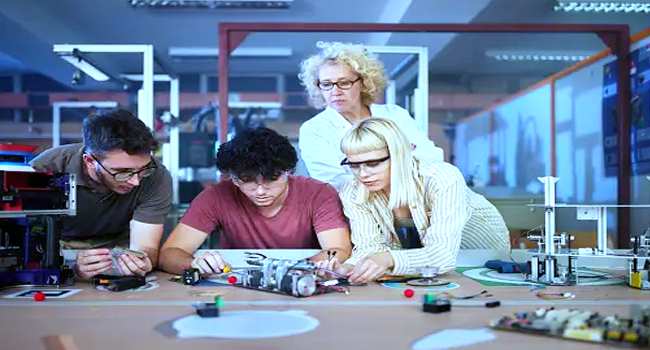In a world in which technology permeates almost every element of our lives, encountering electronic gadgets that malfunction or smash down is an inevitable prevalence. However, instead of resorting to substitutes immediately, many individuals are turning to electronics restoration as a sustainable and price-effective alternative.
With the assistance of complete repair courses and online tutorials, customers are gaining confidence and abilities. This article will discover the landscape of electronics restoration publications in 2024, the assets available to DIY repair fans, and the benefits of using a hands-on technique for maintaining devices.
1. The Rise of DIY Electronics Repair
The do-it-your-self (DIY) electronics repair movement has received significant traction in recent years, pushed by using an aggregate of things, including a growing patron focus on digital waste, the increasing complexity and fee of cutting-edge devices, and a preference for more self-sufficiency.
Instead of relying entirely on manufacturers or expert restoration services, consumers are taking topics into their fingers and studying to troubleshoot and restore their electronic gadgets. This shift towards self-restore no longer best empowers customers to extend their devices’ lifespan but also promotes environmental sustainability by decreasing digital waste and maintaining resources.
2. Accessibility of Repair Resources
One of the key drivers of the DIY electronics restoration movement is the accessibility of restored assets, such as repair courses, tutorials, and online communities. Websites like iFixit, Repair.Org, and The Repair Association provide complete restore courses for digital gadgets.
These courses usually include step-by-step instructions, detailed pics, and troubleshooting tips, making it smooth for customers to identify and fasten common issues without specialized information or gear.
In addition to written guides, video tutorials on structures like YouTube offer visual demonstrations of restore approaches, catering to exclusive studying styles and skill degrees.
3. Tools and Equipment
While some electronics maintenance requires specialized tools and systems, many commonplace maintenance may be finished with fundamental tools that are low-cost and comfortable to have.
Tools with screwdrivers, spudgers, tweezers, and prying equipment are crucial for commencing and disassembling devices without inflicting harm.
Additionally, specialized tools like soldering irons, multimeters, and warmth weapons can be required for more excellent advanced upkeep involving circuitry and issue alternatives.
While investing in high-quality gear can decorate the repair and improve results, DIY enthusiasts often find price range-pleasant options that meet their needs without breaking the bank.
4. Challenges and Rewards of DIY Repair
While DIY electronics restoration offers many benefits, it comes with its truthful percentage of challenges and rewards. One of the most extensive and demanding situations is diagnosing a tool’s malfunction’s root purpose, which may require studies, experimentation, and trial and error.
Further, disassembling and reassembling digital gadgets may be daunting, particularly for novices, and may require persistence and attention to elements.
However, successfully finishing a restoration and restoring a device to its running condition can be exceedingly worthwhile, instilling a sense of accomplishment and satisfaction from overcoming barriers and learning new competencies.
5. Repairing vs. Replacing
In contemporary patron culture, it is often more tremendously handy to sincerely update a malfunctioning device with a brand new one instead of attempting to restore it.
However, this attitude contributes to a tradition of disposability and waste, in which flawlessly practical gadgets are discarded prematurely in the desire of the contemporary model.
By embracing DIY electronics repair, consumers can be free from this intake cycle and have a superb effect on their surroundings by decreasing digital waste and holding resources. Repairing in place of replacing also saves cash because the price of repairing a tool is commonly reduced compared to buying a new one.
6. Legal and Regulatory Landscape
In current years, there has been growing momentum for “right to restore” legislation to ensure clients have the right to restore their electronic gadgets and access vital gear, components, and records.
Several states in the United States have brought proper repair payments, and similar projects are gaining traction in other sector elements.
These efforts promote consumer desire, foster innovation, and create a more excellent, sustainable electronics enterprise by empowering clients to take control of their devices and make their lifespan through repair more extensive.
7. The Future of Electronics Repair
As technology keeps improving and devices become more complicated, the landscape of electronics restoration will continue to conform.
Innovations consisting of modular design, repair-friendly substances, and diagnostic gear powered through synthetic intelligence may also make it less complicated for customers to restore their gadgets in the future.
Additionally, the continuing growth of online restore groups and sharing knowledge and assets will democratize entry store information and empower consumers to take a proactive method to tool upkeep.
Electronics repair courses are critical in empowering purchasers to take control of their digital devices and amplify their lifespan through restoration restoration.
By providing entry to comprehensive repair sources and fostering a tradition of DIY restoration, those guides permit consumers to shop for money, reduce digital waste, and significantly impact the environment.
As the DIY electronics restoration movement continues to gain momentum, the destiny looks bright for an international in which clients have the understanding, competencies, and tools to repair their gadgets and build a more sustainable electronics industry.
FAQs
1. What are DIY electronics restore guides?
DIY electronics repair courses are resources that provide step-by-step instructions, troubleshooting tips, and visual aids to assist people restore their digital devices, such as smartphones, laptops, and kitchen appliances.
2. How accessible are repair sources for DIY electronics fans?
Repair sources for DIY electronics fans are notably on hand, with websites like iFixit, Repair.Org, and The Repair Association imparting comprehensive restoration courses and tutorials for various digital gadgets.
3. What equipment and gadgets are vital for DIY electronics repair?
Essential tools, including screwdrivers, spudgers, and tweezers, are critical for DIY electronics repair, along with specialized equipment like soldering irons and multimeters for superior upkeep concerning circuitry and issue replacement.
4. What challenges do DIY electronics restore fanatics face?
DIY electronics restore lovers may stumble upon challenges, including diagnosing the foundation cause of a tool’s malfunction, disassembling and reassembling gadgets without inflicting harm, and sourcing substitute components and components.
5. How does DIY electronics restoration contribute to sustainability?
DIY electronics restoration contributes to sustainability by decreasing electronic waste and holding resources. Repairing rather than changing gadgets extends their lifespan and reduces the environmental effect of manufacturing and disposal.
6. What are “proper to repair” rules, and why are they important?
“Right to repair” rules ensure customers can repair their digital gadgets and access the essential gear, components, and facts. It promotes purchaser preference, fosters innovation, and creates an extra-sustainable electronics enterprise.
7. What does the future hold for DIY electronics restoration?
The future of DIY electronics restoration seems promising, with improvements along with modular design, restore-friendly substances, and synthetic intelligence-powered diagnostic tools making it less complicated for purchasers to regain their gadgets. Additionally, persistent growth in online restoration groups will democratize the right of entry to repair information and assets.

